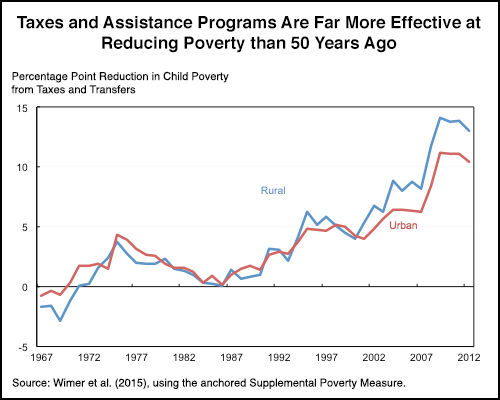
Rural America provides the vast majority of food and energy benefits for the rest of the country, is the source of nearly 90 percent of renewable water resources, and is home to important service sector and manufacturing hubs. Despite this critical role in our nation’s economy, too many Americans in rural areas are not sharing in our nation’s economic growth.
In 2013, 6.2 million Americans in rural areas lived in poverty, including about 1.5 million children. Moreover, in far too many of these communities, high rates of poverty have persisted for generations: Over 300 rural counties have had poverty rates of over 20 percent in every Census since 1980.

While the fight to eliminate poverty is far from over, today, as part of the White House Rural Council’s ongoing efforts to address rural child poverty, we released a report that finds that programs like refundable tax credits, Social Security, SNAP, and housing assistance lifted about 9.0 million rural people out of poverty in 2013, including about 1.6 million children.
The report, entitled Opportunity for All: Fighting Rural Child Poverty, examines poverty in rural areas, discusses the positive impact of safety net programs on reducing rural poverty, and highlights the Administration’s efforts and proposals to reduce poverty and promote opportunity in rural communities.
These efforts not only reduce poverty today, but have helped cut poverty over the last 50 years. The 2014 Economic Report of the President documented that federal programs designed to reduce poverty and promote opportunity have cut poverty by more than one-third over the past 50 years. In this report, we show further that poverty in rural areas has fallen by nearly half between 1967 and 2012, compared to about one-quarter in urban areas.

Among poor rural children, programs like Social Security and SNAP have profound impacts on well-being. Social Security reduces the share of children living in deep poverty — below half the poverty line — by nearly one-half, while SNAP cuts deep child poverty by about 30 percent.


In addition to the safety net’s dramatic impact on reducing hardship among urban and rural children alike, a growing body of evidence shows that federal investments that provide assistance to low-income children provide very large long-run returns. Increasing the resources available to poor children and their families improves children’s education, health, and earnings outcomes later in life.
Yet much more needs to be done. President Obama recently remarked, “In order to ensure that all Americans are able to reach the first rung on the ladder of opportunity, we must continue to invest in the types programs that we know have worked to produce our successes to date.”
The President has laid out an agenda that would do just that — make the investments needed to promote opportunity and reduce poverty in the near and long term. That agenda:
- Ends the sequestration cuts that would cut funding for programs like Head Start, Preschool Development Grants, Housing Choice Vouchers and Homeless Assistance Grants, job training, and rural infrastructure — programs that have been shown to help kids and families succeed
- Makes permanent the 2009 expansion of refundable credits and prevent a tax increase on 16 million working families with children
- Supports state efforts to expand Medicaid — critically important in rural areas, since nearly two-thirds of the rural uninsured live in states that elected not to expand Medicaid eligibility under the Affordable Care Act
- Increases the minimum wage to ensure that no full-time worker raises his or her family in poverty
- Helps students access college and build their skills by proposing extending the American Opportunity Tax Credit and making two years of community college free for responsible students
- Prevents the harmful cuts to the safety net, including the SNAP program, proposed by the Republican budget
- Protects Social Security retirement and disability insurance programs, which provide critical assistance to millions of American families, including for 1.2 million rural children lifted out of poverty
- Leverages technology to improve access to services, including programs like HHS’ Rural Child Poverty Telehealth Network Grant Program and USDA’s Distance Learning and Telemedicine Grant Program, which are testing new ways to use telehealth technologies to link rural children with specialized health and human services that may not be available locally
Rural America continues to be a source of strength and opportunity for both the people who live there and for the nation as a whole. The Administration aims to build upon the progress we have already made in reducing rural poverty, by leveraging technology, forging new partnerships, and exploring new models of program delivery, to ensure that all kids have an opportunity to succeed.
Shaun Donovan is the Director of the Office of Management and Budget. Cecilia Muñoz is Assistant to the President and the Director of the Domestic Policy Council. Jason Furman is the Chairman of the Council of Economic Advisers.

